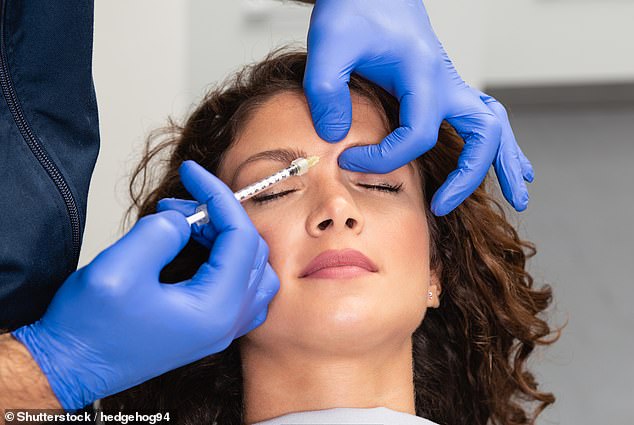Painful cure for ‘tech neck’ increasingly requested by patients, doctors reveal
You may find yourself doing this several times a day: hunched over your phone, which puts a huge strain on your neck.
Many Britons suffering from ‘tech neck’, a condition caused by hunching over devices such as phones or tablets, are turning to Botox to help remedy the problem, doctors have revealed.
The ‘tech neck’ treatment is called ‘traptox’, because the trapezius muscles in the neck are targeted by the injections. The treatment costs around £600.
It works in the same way as cosmetic injections for wrinkles: it paralyses the nerve signals that cause muscles to contract, causing them to relax and, in the case of the neck, improving mobility.
Some doctors in London report seeing up to 10 patients a month who want to use traptox to relieve their neck pain. Some patients need a booster shot every six to nine months.
Some doctors in London report seeing up to 10 patients a month using Traptox to relieve their neck pain, with some patients needing booster shots every six to nine months.
Dr. Ashwin Soni, a plastic and reconstructive surgeon, told The Telegraph The number of patients seeking this treatment increased.
“A lot of them are in pain because they’re constantly bending their neck forward and not paying attention to their posture,” he said.
‘I probably see about 10 patients a month right now, and most of them are over 40.
‘Perhaps they’ve spent years hunched over their desk or smartphone and haven’t paid proper attention to their posture.
Dr. Soni added that he only gives people “one or two” injections of Traptox as a “quick fix,” before recommending patients see a professional such as a physical therapist or do a range-of-motion exercise that improves their mobility, such as yoga or Pilates.
This is according to new evidence from researchers at Kings College London on the impact that hunching over technology has on our necks.
This study was presented at an event at the Royal Society of Medicine’s Department of Aesthetic Medicine and Surgery. It found that the human head in a normal, tense position exerts approximately 5 kg (11 lbs) of pressure on the spine.
But if you have a curved ‘tech neck’, the load quadruples to as much as 22 kg (48 lbs).
Poor neck posture can not only lead to pain, but also to all sorts of other problems, such as tension headaches, muscle spasms, and even the development of painful bone spurs in the neck joints.
While smartphone-loving adults are most at risk for “tech neck,” doctors worry future generations could face even greater problems.
Previous studies have shown that children between the ages of two and eleven spend up to 4.5 hours a day in front of a screen, which is much more than the recommended time.
According to analysts, children between the ages of two and 11 watch more than four times the recommended amount (4.5 hours per day) of recorded programming, the Journal reports.
More recent British research shows that young people between the ages of eight and eighteen listen to music for about four hours a day, compared to five hours for adults.
Some doctors warn that they are seeing more and more children experiencing problems due to technology use.
Examples include torticollis, where the neck muscles spasm and the head tilts to one side, and general reduced mobility due to being glued to equipment.
The World Health Organization recommends that children spend no more than one hour per day in front of a screen.

Britons suffering from ‘tech neck’, caused by spending too much time hunched over devices such as phones or tablets, are turning to Botox to help, doctors have revealed.

Nearly four in five Britons who receive anti-wrinkle injections suffer adverse side effects, research shows
Tech neck prevention tips include limiting screen time and, if work or education doesn’t allow this, placing screens at eye level to reduce strain on muscles and joints.
Aesthetic treatments using botulinum toxin (the best known brand is Botox) are not reimbursed by the NHS.
It is available to patients with certain health conditions who may benefit from Botox’s ability to paralyze certain tissues.
These include substances that cause spasms, migraines and excessive sweating.
Although Botox is generally considered safe, as with any medication, there is a risk of side effects that can vary in severity.
Research published last year found that nearly four in five Britons who receive anti-wrinkle injections suffer such side effects, with the most common side effects being headaches, pain, dizziness and brain fog.
